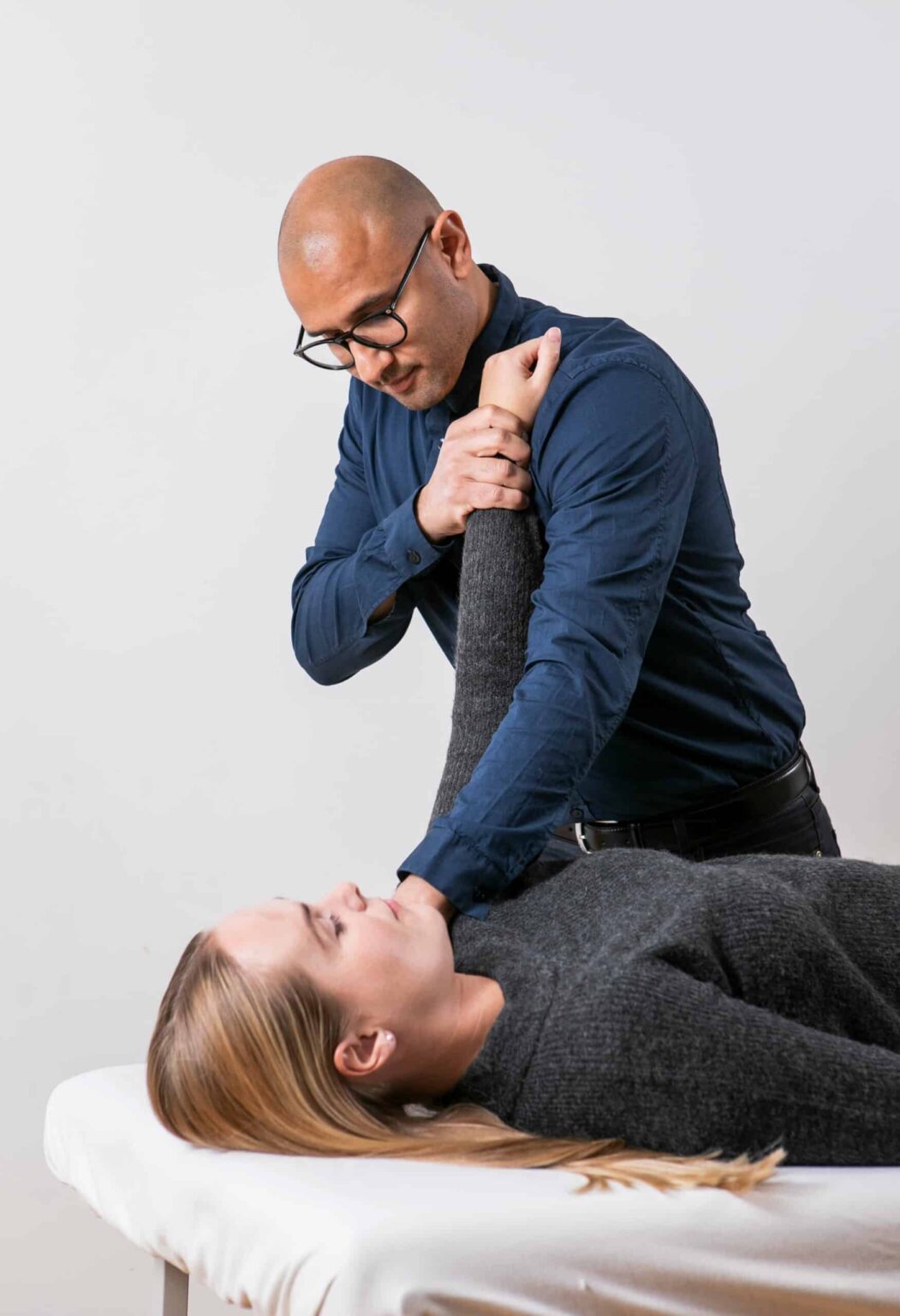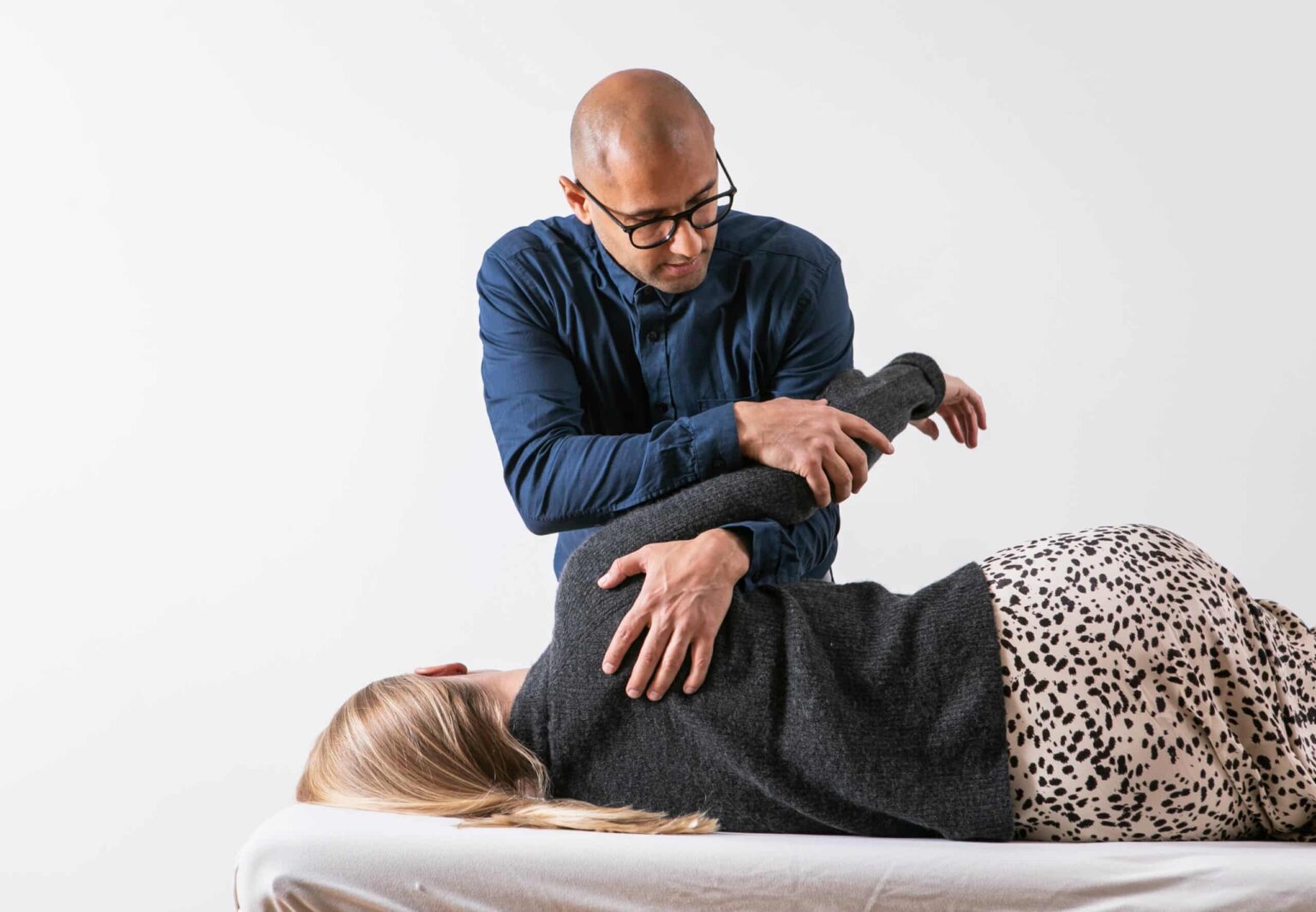We treat
Shoulder dislocation
Learn more about shoulder dislocation and its treatment
What is shoulder dislocation?
A shoulder dislocation is a condition in which the bones in the shoulder joint separate from each other. This means that the shoulder joint is dislocated and not in its normal position, which can cause pain, limited movement, and reduced function of the arm.
Jump to section [Vis]
The two types of shoulder dislocation
Shoulder dislocation can be divided into two types:
Anterior shoulder dislocation
This type is the most common and occurs when the shoulder joint moves forward and out of joint. This can happen as a result of a forceful or unexpected movement of the arm, a direct blow to the shoulder, or a fall on an outstretched arm.
Posterior shoulder dislocation
This is a less common type where the shoulder joint moves backward and out of joint. It can occur as a result of extreme force or trauma to the front of the shoulder.
Source: Sundhed.dk

Causes of shoulder dislocation
Shoulder dislocation can occur due to various reasons, such as:
- Trauma: The most common cause of shoulder dislocation is trauma, such as a fall, blow, or sudden forceful load on the shoulder. The trauma can lead to a sharp displacement of the shoulder joint head, resulting in dislocation.
. - Weakness in the shoulder muscles: If the muscles and tendons that support the shoulder are weak or overstretched, they may have difficulty holding the shoulder joint in place. This can lead to repeated episodes of shoulder dislocation.
. - Hypermobility: Some people naturally have very mobile joints, which increases the risk of shoulder dislocation. Hypermobility can be genetic or caused by connective tissue diseases such as Ehlers-Danlos syndrome.
. - Repetitive overload: Repetitive movements or overloads of the shoulder, such as repeated throwing in certain sports or repeated lifting of heavy objects, can over time weaken the stabilizing structures of the shoulder and increase the risk of dislocation.
Symptoms of shoulder dislocation
The symptoms of shoulder dislocation can vary in severity depending on the type of dislocation. However, in general, the following symptoms are typically present:
Shoulder pain:
Acute and intense pain in the shoulder area is a typical symptom of shoulder dislocation. The pain can be sudden and intense during the actual shoulder dislocation.
Deformity:
A visible deformity may be present in the shoulder area, where the humeral head is no longer positioned correctly in the shoulder joint. This can result in an unusual shape or position of the shoulder.
Reduced mobility:
After a shoulder dislocation, movement in the shoulder may be limited. It may be painful or difficult to move the arm and shoulder as usual.
Swelling and tenderness:
The shoulder area may swell and be tender to the touch. The swelling is usually due to inflammation and tissue damage from the dislocation.
Bruises and discoloration:
Discoloration of the skin around the shoulder area can occur due to damage to the blood vessels resulting from shoulder dislocation.

Treatment options for shoulder dislocation
Treatment for shoulder dislocation can vary depending on the degree of the injury and individual factors.
Reduction:
If the shoulder has been dislocated, the doctor will usually try to reduce it by gently manipulating the shoulder back into place. This can be done manually or with the help of imaging tests such as an X-ray.
Immobilization:
After dislocation adjustment, the shoulder may be immobilized using a sling or bandage to keep the shoulder in a stable position. This helps prevent repeated dislocations and allows time for healing.
Rehabilitation:
Once the shoulder has been stabilized, training may be necessary to restore strength, mobility, and stability to the shoulder. Exercises and therapeutic techniques can be used to improve muscle strength around the shoulder and restore normal function.
Surgery:
In some cases, surgery may be necessary, especially if there are repeated dislocations, severe ligament damage, or other accompanying injuries. Surgical intervention may involve repairing or tightening the damaged structures in the shoulder to prevent repeated dislocations.
Sick leave
Following a shoulder dislocation, where the shoulder has been partially or completely displaced from its normal position, varying degrees of damage to the joint, ligaments, muscles, and surrounding tissues can occur. The exact severity and extent of the damage will vary from person to person depending on several factors, including the type of dislocation.
Here are some general guidelines:
- Starting work: Depending on the job but approximately 3 weeks.
- Lighter sports such as running, cycling, swimming: Approximately 6 weeks.
- Contact sports, vaulting gymnastics and racket sports: Approximately 3 months.

What is the difference between shoulder dislocation and shoulder sprain?
Shoulder dislocation and shoulder sprain are two different injuries that affect the shoulder joint, but they differ in severity and extent of injury. In a shoulder dislocation, the bones become separated from each other, while a shoulder sprain is a minor injury where the shoulder joint experiences a temporary displacement or sprain, but without being completely seperated. It can be divided into different degrees:
First degree sprain:
Mildest form of sprain, where the ligaments around the shoulder joint are stretched but not torn.
Second-degree sprain:
Moderate sprain, where the ligaments are stretched and partially torn.
Third-degree sprain:
The most serious form of sprain, where the ligaments are completely torn and the shoulder joint may have significant instability.
In general, shoulder dislocation is more serious than shoulder sprain, as the joint goes completely out of position in the case of dislocation.
What to do if your shoulder dislocates?
Shoulder dislocation can be a painful and serious condition that requires immediate attention and appropriate management. Here are some steps for recognizing and managing shoulder dislocation:
How to recognize shoulder dislocation
Be aware of the symptoms: A person with a shoulder dislocation will usually experience sudden and intense pain in the shoulder area followed by limited mobility and deformity of the shoulder.
Observe the shoulder area: Look for obvious signs of a shoulder dislocation, such as a visible displacement of the shoulder joint or a “square” appearance of the shoulder area compared to the opposite shoulder.
Listen to the patient’s description: Ask the patient about what happened and whether they are experiencing pain, weakness, or a feeling that their shoulder is out of place.
How to handle shoulder dislocation in others
Support and reassure the person: Help the person find a comfortable position and encourage them to remain as calm as possible to reduce pain and prevent further injury.
Seek medical attention: Shoulder dislocation should be evaluated and treated by a healthcare professional.
Avoid manipulating the shoulder: Unless you are a trained healthcare professional, you should avoid attempting to reduce a shoulder dislocation by manipulating the shoulder. Improper handling can worsen the injury or cause further complications.
Osteopathic approach to shoulder dislocation
A good and well-functioning shoulder requires good blood flow to and from the shoulder. The blood transports oxygen, nutrients and cleansing substances, which is essential for healing of muscles, tendons, bone tissue and ligaments in the shoulder. In order for this to occur optimally, an osteopath will likely include:
- Joint mobilization techniques of the neck and mid-back, as good mobility in these joints is essential for shoulder mobility.
- Reduce any compression of the brachial plexus (nerve bundle that extends from the lower part of the neck and provides nerves to the arm and shoulder), so that good nerve conduction and control can occur after dislocation trauma.
- Mobilizing techniques and exercises for lung tissue, as it attaches to the lower part of the neck and can affect shoulder mobility.
- Work with the rib, chest and lung circulation to optimize healing via blood supply.
- Local techniques around the shoulder blade and shoulder head that can facilitate better drainage (relieve local pressure) and reduce pain as well as a better response to strength training.
- Dietary guidance, as after a mechanical trauma it is very important that you, for example, get enough protein intake, as it is essential in a reconstruction phase that there are enough “building blocks”. This also looks at micronutrients (vitamins) and how these can be optimized for the best possible recovery.

Rehabilitation after shoulder dislocation
Rehabilitation after a shoulder dislocation is important to restore strength, mobility, and stability in the shoulder, as well as prevent repetitive injuries. Rehabilitation may vary depending on the degree of shoulder dislocation and individual factors.
Immobilization and Rest: Initially, it may be necessary to immobilize the shoulder using a shoulder bandage, splint, or cast to stabilize the shoulder joint and allow healing. It is important to follow instructions about rest and limiting activities during this phase.
Range of motion exercises: As the healing process progresses, the focus will shift to regaining shoulder mobility. This may include passive exercises, where a therapist gently moves your shoulder, or active exercises, where you perform the movements yourself.
Strength training: As your shoulder becomes more stable, you will gradually begin to work on rebuilding strength in your shoulder muscles. This may involve using light weights, resistance bands, or bodyweight exercises. The focus will be on the muscles around your shoulder blade and the rotator cuff muscles.
Stabilization exercises: To prevent recurrent shoulder dislocations, it is important to retrain shoulder stability and coordination. This may involve specific exercises that target the deep muscles of the shoulder and shoulder blade to maintain good control and stability during movement.
Gradual return to activity: As your shoulder becomes stronger and more stable, rehabilitation will focus on specific activities and sports you want to return to. This may involve sport-specific exercises, technique training, and gradual increases in load.
Source: Regionshospitalet Horsens
Good tips for preventing shoulder dislocation
To strengthen and protect the shoulder joint, it is important to engage in exercises that target the surrounding muscles and structures.
Strength training: Perform regular strength training to build the muscles around the shoulder joint. Exercises such as shoulder presses, lateral raises, front raises, rowing exercises, and push-ups can be beneficial. It is important to focus on the front, back, and lateral parts of the shoulder muscles to achieve balance.
Rotator cuff exercises: The rotator cuff muscles play a crucial role in shoulder stability. Include exercises that target these muscles, such as band external rotation, band internal rotation, Y and T exercises, and rotation exercises with light weights.
Flexibility exercises: Maintain or improve flexibility in the shoulder area by performing stretching exercises. Stretching the chest, shoulder, and bicep muscles can help maintain good posture and prevent shoulder problems.
Proper technique: While exercising or lifting heavy objects, it is important to maintain proper technique and posture. Improper lifting technique can put undue stress on the shoulder joint and lead to injury.
Avoid overloading: Avoid repetitive and excessive movements that can overload the shoulder joint. If you participate in activities with repetitive arm movements, be sure to take breaks and vary your movements.
Gradual progression: When you exercise or increase the intensity of your exercises, do so gradually. This gives your muscles and joints time to adapt and avoid overuse injuries.

Often related injuries

Shoulder dislocation

Winged scapula

Rotator cuff injuries

Shoulder pain

Frozen shoulder

